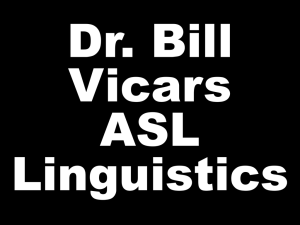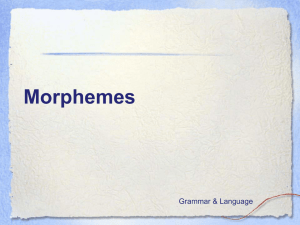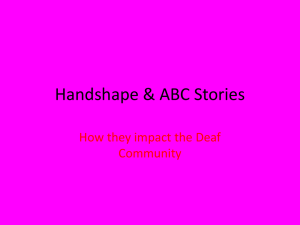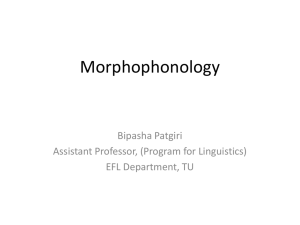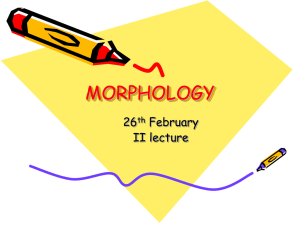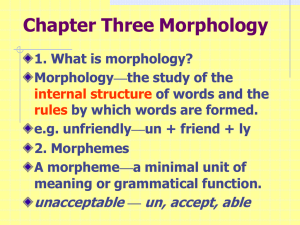Powerpoint: Linguistics-5ed-p56-
advertisement
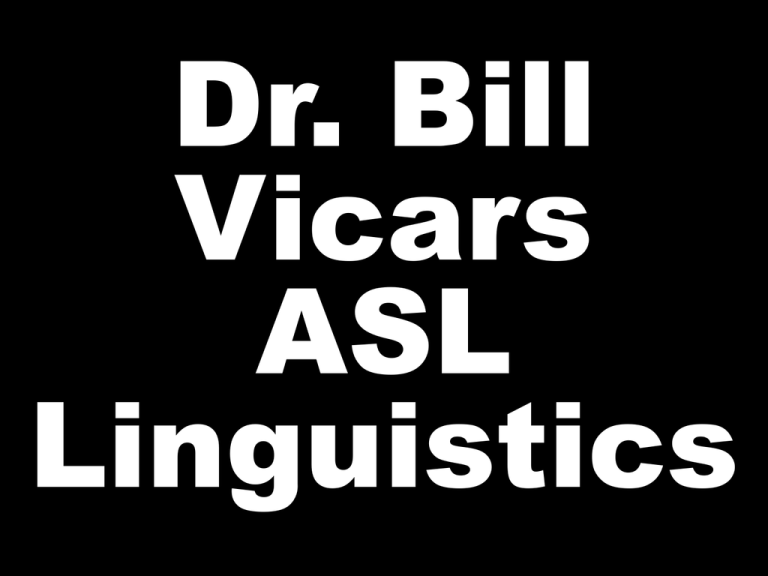
Dr. Bill Vicars ASL Linguistics Quick Review: What is phonology? Phonology is a study of the smallest contrastive units of a language. What two types of segments are signs segmented into? Signs are segmented into holds and movements. During the hold portion of a sign what parameters does that sign have? Handshape Orientation Location Nonmanual During the movement segment of a sign what parameters does that sign have? Handshape Orientation Location (!) Nonmanual LOUSY AWKWARD PREACH 3-MONTH 3-DOLLARS 9-WEEKS [49] What is morphology? Morphology is the study of the smallest MEANINGFUL units of language and how those units are used to build new words (or signs). [51] [51] [53] [53] [55] [57] The first contact rule, the single sequence rule, and the weak hand anticipation rule are morphological rules. [57] “GOOD” and “NIGHT” [58] “GOOD-NIGHT” [58] [59] Movement epenthesis, hold deletion, and assimilation are phonological rules. [59] [60] English: GREEN-HOUSE (Does that mean a house that is green?) Compounds create new meanings. Example: THINK-MARRIAGE “BELIEVE” Review Activity In considering phonology and morphology, which of the following signs doesn’t fit with the other on the list? [p49] a. LOUSY b. AWKWARD c. THREE-DOLLARS (In this sign, the three handshape functions as a morpheme] d. PREACH THREE-DOLLARS (In this sign, the three handshape functions as a morpheme] In English, adding “er” to the term “walk” to create “walker” is an example of: [p52] a. creating a process morpheme b. using a form morpheme to create a noun from a verb c. adding a free morpheme to create a process d. a compound word In English, adding “er” to the term “walk” to create “walker” is an example of: [p52] * using a form morpheme to create a noun from a verb In English, emphasizing or “stressing” the first syllable of the word subject instead of the second syllable, is an example of: [p52] a. using a process morpheme to create a noun from a verb b. using a form morpheme to create a noun from a verb c. adding a free morpheme to create a process d. a compound word In English, emphasizing or “stressing” the first syllable of the word subject instead of the second syllable, is an example of: [p52] * using a process morpheme to create a noun from a verb What types of signs differ in their movement but share the same handshape, location, and orientation? [p52] a. compound pairs b. noun-verb pairs c. form morphemes d. cheremes What types of signs differ in their movement but share the same handshape, location, and orientation? [p52] * noun-verb pairs The process of repetition is called: [p54] a. affixation b. compounding c. lexicalization d. reduplication The process of repetition is called: [p54] * reduplication The process of adding bound morphemes to other forms to create new units is called: [p54] a. affixation b. compounding c. lexicalization d. attachment The process of adding bound morphemes to other forms to create new units is called: [p54] * affixation The use of affixation in ASL would result in the creation of a: [p54] a. form morpheme b. process morpheme c. lexicalized sign d. reduplicated sign The use of affixation in ASL would result in the creation of a: [p54] * form morpheme Noun-verb pairs provide an example of: [p54] a. creation of a form morpheme b. creation of a process morpheme c. lexicalized signs d. compounding Noun-verb pairs provide an example of: [p54] * creation of a process morpheme The creation of a new word by combining two free morphemes is called: [p56] a. noun-verb pairing b. affixation c. incorporation d. compounding The creation of a new word by combining two free morphemes is called: [p56] * compounding The first contact rule applies to: [p57] a. nonmanual markers b. compounds c. determiners d. the weak hand The first contact rule applies to: [p57] * b. compounds When compounds are made in ASL, internal movement or the repetition of movement is eliminated. This principle is called: [p58] a. topicalization b. reciprocity c. The single sequence rule d. segmenting When compounds are made in ASL, internal movement or the repetition of movement is eliminated. This principle is called: [p58] * The single sequence rule When a right handed signer signs the concept “BELIEVE,” (which is made up from the signs “THINK” and “MARRY”) his left hand is formed into a “C” handshape while the right hand is signing “THINK.” This is an example of: [p58] a. weak hand anticipation rule b. reciprocity c. The simple sequence rule d. prediction rule When a right handed signer signs the concept “BELIEVE,” (which is made up from the signs “THINK” and “MARRY”) his left hand is formed into a “C” handshape while the right hand is signing “THINK.” This is an example of: [p58] * weak hand anticipation rule Movement epenthesis, hold deletion, and assimilation are what kind of rules? [p59] a. Morphological rules b. Phonological rules c. Syntactic rules d. Pragmatic rules Movement epenthesis, hold deletion, and assimilation are what kind of rules? [p59] * Phonological rules The first contact rule, the single sequence rule, and the weak hand anticipation rule are what kind of rules [p57] a. morphological rules b. phonological rules c. syntactic rules d. pragmatic rules The first contact rule, the single sequence rule, and the weak hand anticipation rule are what kind of rules [p57] * morphological rules In the compound sign THINKSAME, a movement segment is added between the final hold of THINK and the first movement of SAME. This is an example of: [p59] a. the simple sequence rule b. assimilation c. movement epenthesis d. weak hand anticipation In the compound sign THINKSAME, a movement segment is added between the final hold of THINK and the first movement of SAME. This is an example of: [p59] * movement epenthesis When two signs are compounded, the noncontact holds between movements are eliminated. This principle is: [p41 & p59] a. the simple sequence rule b. assimilation c. hold deletion d. movement epenthesis When two signs are compounded, the noncontact holds between movements are eliminated. This principle is: [p41 & p59] * hold deletion If I do the sign BELIEVE, and at the beginning of the sign my right hand forms on somewhat of a “C” handshape (rather than the typical “1” handshape) what is taking place? [p59] a. assimilation b. sloppy signing c. accommodation d. contamination If I do the sign BELIEVE, and at the beginning of the sign my right hand forms on somewhat of a “C” handshape (rather than the typical “1” handshape) what is taking place? [p59] * assimilation LOOK and STRONG come together (compound) to form the sign: [p59] a. "believe" b. "remember" c. "far sighted" d. "resemble" LOOK and STRONG come together (compound) to form the sign: [p59] * "resemble" What is the study of the smallest contrastive parts of language that do not have independent meaning? [p49] a. phonology b. morphology c. dactylology d. lexicostatistics What is the study of the smallest contrastive parts of language that do not have independent meaning? [p49] * phonology
